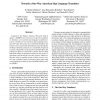ACL
2007
14 years 1 months ago
2007
Speech recognition in many morphologically rich languages suffers from a very high out-of-vocabulary (OOV) ratio. Earlier work has shown that vocabulary decomposition methods can ...
ECAI
2008
Springer
14 years 2 months ago
2008
Springer
Abstract. The paper presents an implemented model for priming speech recognition, using contextual information about salient entities. The underlying hypothesis is that, in human-r...
DAGM
2008
Springer
14 years 2 months ago
2008
Springer
Performance of speech recognition systems strongly degrades in the presence of background noise, like the driving noise in the interior of a car. We compare two different Kalman fi...
CLEF
2006
Springer
14 years 2 months ago
2006
Springer
This paper presents the second participation of the University of Ottawa group in the Cross-Language Speech Retrieval (CL-SR) task at CLEF 2006. We present the results of the submi...
CHINZ
2008
ACM
14 years 2 months ago
2008
ACM
As performance gains in automatic speech recognition systems plateau, improvements to existing applications of speech recognition technology seem more likely to come from better u...
AVI
2008
14 years 2 months ago
2008
This paper presents an interactive visualisation system that assists users of semi-automatic speech transcription systems to assess alternative recognition results in real time an...
AAAI
2008
14 years 2 months ago
2008
This paper debuts a novel application of speech recognition to foreign language learning. We present a generic framework for developing user-customizable card games designed to ai...
PROPOR
2010
Springer
14 years 3 months ago
2010
Springer
Abstract. This work is part of the effort to develop a speech recognition system for Brazilian Portuguese. The resources for the training and test stages of this system, such as c...
ISMIR
2000
Springer
14 years 4 months ago
2000
Springer
We examine in some detail Mel Frequency Cepstral Coefficients (MFCCs) - the dominant features used for speech recognition - and investigate their applicability to modeling music. ...
FGR
2004
IEEE
14 years 4 months ago
2004
IEEE
Inspired by the Defense Advanced Research Projects Agency's (DARPA) recent successes in speech recognition, we introduce a new task for sign language recognition research: a ...






